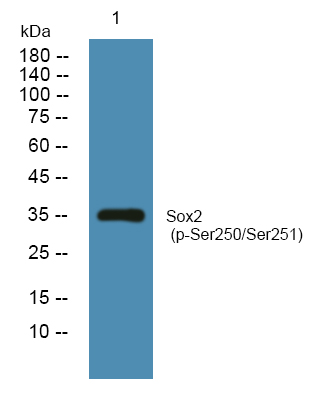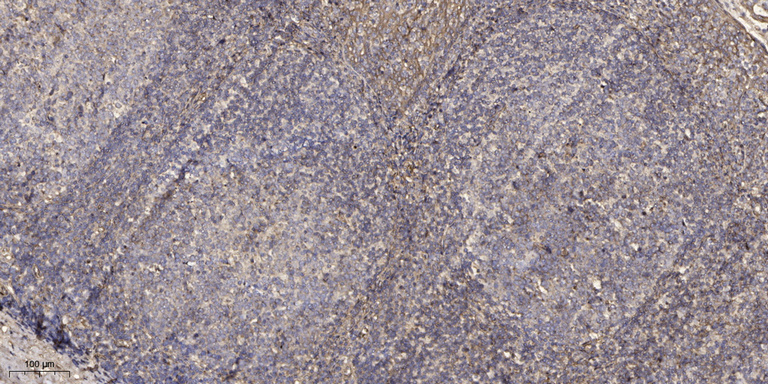Sox2 (Phospho Ser250/251) Rabbit pAb
- Catalog Number : AP1503
- Number : AP1503
-
Size:
Qty : - Price : Request 詢價
- Stock : Request
General Information
| Reactivity | Human, Mouse | |||||||||
|---|---|---|---|---|---|---|---|---|---|---|
| Application | WB, IHC | |||||||||
| Host | Rabbit | |||||||||
| Clonality | Polyclonal | |||||||||
| Conjugate | Non-conjugated | |||||||||
| Isotype | IgG | |||||||||
| Immunogen | Synthesized phosho peptide around human Sox2 (Ser250 and Ser251) | |||||||||
| Molecular Weight | 35kD (Observed) | |||||||||
| Storage buffer | Liquid in PBS containing 50% glycerol, 0.5% BSA and 0.02% sodium azide. | |||||||||
| Storage instruction | -15°C to -25°C/1 year(Do not lower than -25°C) | |||||||||
| Research topic | >>Hippo signaling pathway>>Signaling pathways regulating pluripotency of stem cells | |||||||||
| Alias | Transcription factor SOX-2 | |||||||||
| Recommended Dilution Ratio | WB 1:500-2000; IHC 1:50-300 | |||||||||
| Specificity | This antibody detects endogenous levels of SOX-2 only when phosphorylated at Ser250/Ser251,and dually phosphorylated at two sites. | |||||||||
| Purification | The antibody was affinity-purified from rabbit serum by affinity-chromatography using specific immunogen. | |||||||||
| Gene Name | SOX2 | |||||||||
| Protein Name | Sox2 (Ser250/Ser251) | |||||||||
| Database Link |
| |||||||||
| Background | SRY-box 2(SOX2) Homo sapiens This intronless gene encodes a member of the SRY-related HMG-box (SOX) family of transcription factors involved in the regulation of embryonic development and in the determination of cell fate. The product of this gene is required for stem-cell maintenance in the central nervous system, and also regulates gene expression in the stomach. Mutations in this gene have been associated with optic nerve hypoplasia and with syndromic microphthalmia, a severe form of structural eye malformation. This gene lies within an intron of another gene called SOX2 overlapping transcript (SOX2OT). [provided by RefSeq, Jul 2008]. | |||||||||
| Function | Disease:Defects in SOX2 are the cause of microphthalmia syndromic type 3 (MCOPS3) [MIM:206900]. Microphthalmia is a clinically heterogeneous disorder of eye formation, ranging from small size of a single eye to complete bilateral absence of ocular tissues (anophthalmia). In many cases, microphthalmia/anophthalmia occurs in association with syndromes that include non-ocular abnormalities. MCOPS3 is characterized by the rare association of malformations including uni- or bilateral anophthalmia or microphthalmia, and esophageal atresia with trachoesophageal fistula.,Function:Transcription factor that forms a trimeric complex with OCT4 on DNA and controls the expression of a number of genes involved in embryonic development such as YES1, FGF4, UTF1 and ZFP206. Critical for early embryogenesis and for embryonic stem cell pluripotency.,online information:Sox2 entry,PTM:Sumoylation inhibits binding on DNA and negatively regulates the FGF4 transactivation.,similarity:Contains 1 HMG box DNA-binding domain. | |||||||||
| Cellular Localization | Nucleus speckle . Cytoplasm . Nucleus . Acetylation contributes to its nuclear localization and deacetylation by HDAC3 induces a cytoplasmic delocalization (By similarity). Colocalizes in the nucleus with ZNF208 isoform KRAB-O and tyrosine hydroxylase (TH) (By similarity). Colocalizes with SOX6 in speckles. Colocalizes with CAML in the nucleus (By similarity). Nuclear import is facilitated by XPO4, a protein that usually acts as a nuclear export signal receptor (By similarity). | |||||||||
| Tissue Expression | Fetal brain,Lung,Retina. | |||||||||
| Validation Data |
Western blot analysis of lysates from SH-SY5Y cells, primary antibody was diluted at 1:1000, 4°over night | |||||||||
Immunohistochemical analysis of paraffin-embedded human tonsil. 1, Antibody was diluted at 1:200(4° overnight). 2, Tris-EDTA,pH9.0 was used for antigen retrieval. 3,Secondary antibody was diluted at 1:200(room temperature, 45min). |










.png)